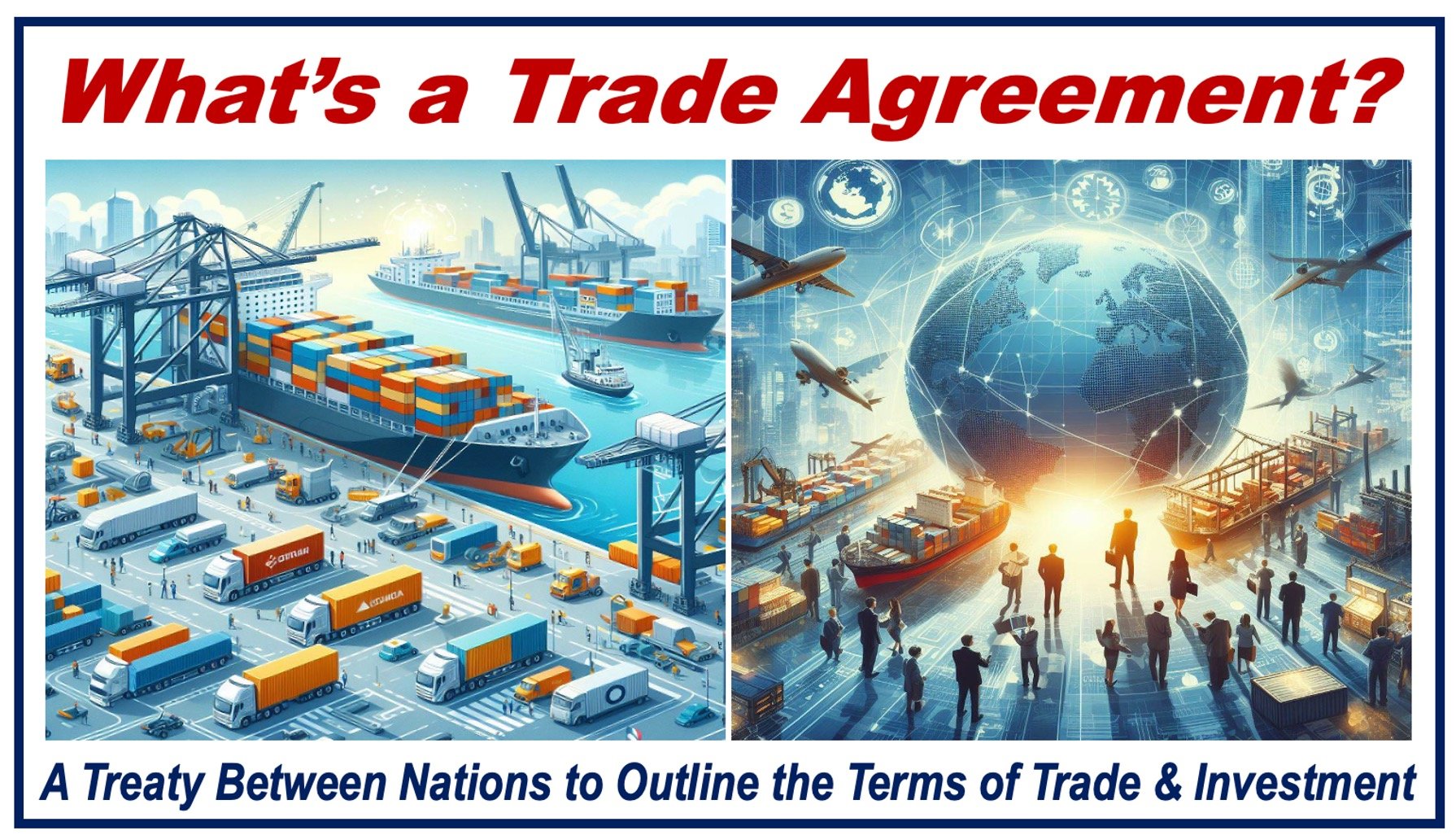Trade Agreements are essential tools that countries across the world use to facilitate smother and more efficient international trade.
These agreements, which are often negotiated over years, set rules for international trade, aiming to eliminate or minimize barriers that could undermine the flow of products and services between nations.
At their core, trade agreements are about creating opportunities for participating countries. They open up markets for businesses that might otherwise face steep tariffs, quotas, or stringent regulations when trying to export.
These agreements level the playing field and help businesses expand, create new jobs, and foster economic growth.
Put simply, trade agreements help countries become more prosperous.
The Business Development Bank of Canada has the following definition of the term:
“A free trade agreement (FTA) is a treaty between two or more countries to facilitate trade and eliminate trade barriers. It aims at eliminating tariffs completely from day one or over a certain number of years. Free trade agreements help create an open and competitive international marketplace.”
Types of trade agreements
There are several types of trade agreements. Let’s have a look at some of them:
-
Bilateral Trade Agreements
Agreements between two countries to reduce trade barriers, like tariffs, to bolster trade between them.
-
Multilateral Trade Agreements
Involve multiple countries working together to establish common trade standards and reduce barriers on a broader scale.

-
Free Trade Agreements (FTAs)
Aim to eliminate or reduce tariffs and quotas between member countries to facilitate free trade.
-
Customs Unions
Member countries agree to eliminate trade barriers among themselves and adopt a common external tariff against non-members.
-
Economic Partnership Agreements (EPAs)
Focus on trade and development, particularly between the EU and specific regions, aiming to integrate these economies into the global market.
-
Regional Trade Agreements (RTAs)
Treaties between countries in the same region to reduce trade barriers and promote economic integration.
-
Preferential Trade Agreements (PTAs)
Offer preferential tariff rates to partner countries, less comprehensive than FTAs but aim to boost trade by lowering tariffs on specific goods.
Scope
We can also categorize trade agreements according to their scope. Some focus purely on tariffs and trade in goods, while others cover a wide range of issues; these are known as comprehensive agreements. Their aim is not just to boost trade but also to ensure that this trade growth contributes positively to societal goals.
Comprehensive agreements may cover intellectual property rights, environmental protection, labor standards, investment protections, e-commerce, and regulatory cooperation.
Current trade agreements
Below is a list of the major trade agreements in existence today:
- United States-Mexico-Canada Agreement (USMCA)
Effective from July 1, 2020. Formerly the North American Free Trade Agreement (NAFTA), which came into effect on January 1, 1994. - European Single Market (ESM)
Officially completed on January 1, 1993, under the Treaty of Maastricht. - Comprehensive and Progressive Agreement for Trans-Pacific Partnership (CPTPP)
Signed on March 8, 2018. - Regional Comprehensive Economic Partnership (RCEP)
Signed on November 15, 2020. - Common Market for Eastern and Southern Africa (COMESA)
Formed in December 1994. - Southern Common Market (MERCOSUR)
Established by the Treaty of Asunción on March 26, 1991.
Trade agreements take time to complete
The negotiation of trade agreements is a meticulous process. Negotiators must balance national interests with the desire to gain market access abroad. They must consider the impact on different sectors of their countries’ economies, from agriculture to manufacturing to services.
The goal of the negotiators is to find a mutually beneficial agreement that facilitates two things:
- Boost trade.
- Protect domestic industries from unfair competition.
A controversial subject
Supporters of trade agreements argue that free trade helps boost economic growth, lowers consumer prices, widens consumer choice, and encourages innovation.
Critics, on the other hand, point to the risk of job losses in industries that cannot compete with imported goods. They also worry that labor and environmental standards will fall.
Trade agreements – conclusion
Trade agreements are foundational elements of global commerce. They are designed to foster international trade by reducing barriers.
While they offer significant benefits, people continue to argue about their pros and cons.
Video – What is International Trade?
This video presentation, from our sister channel on YouTube – Marketing Business Network, explains what a ‘International Trade’ is using simple and easy-to-understand language and examples.
